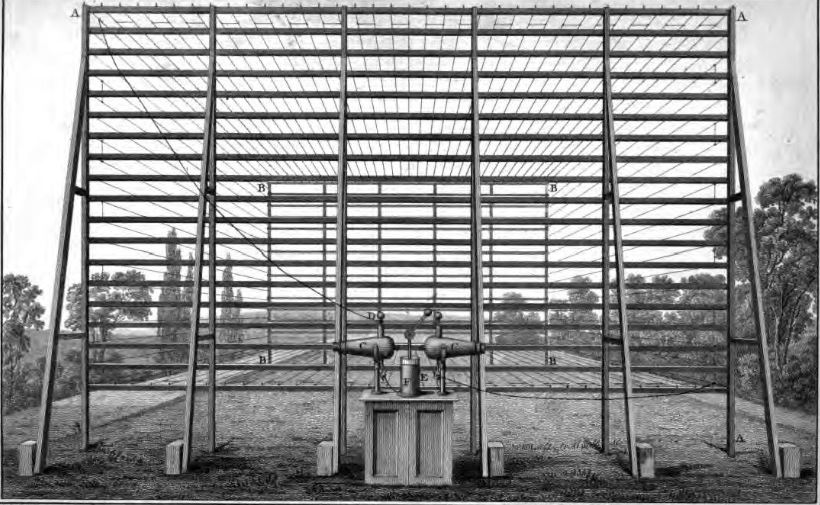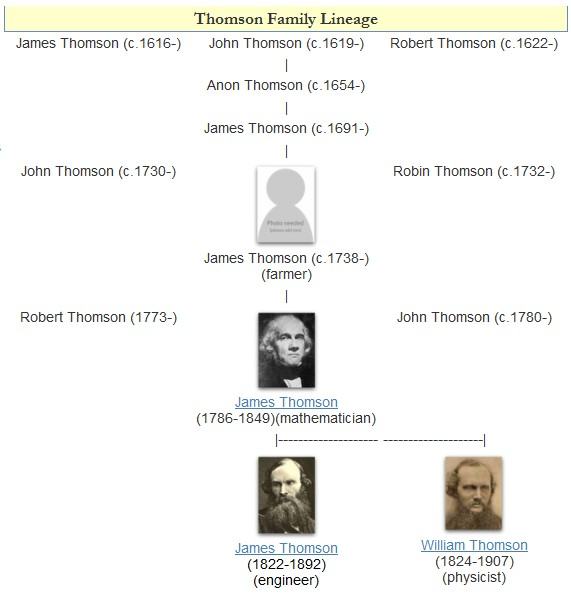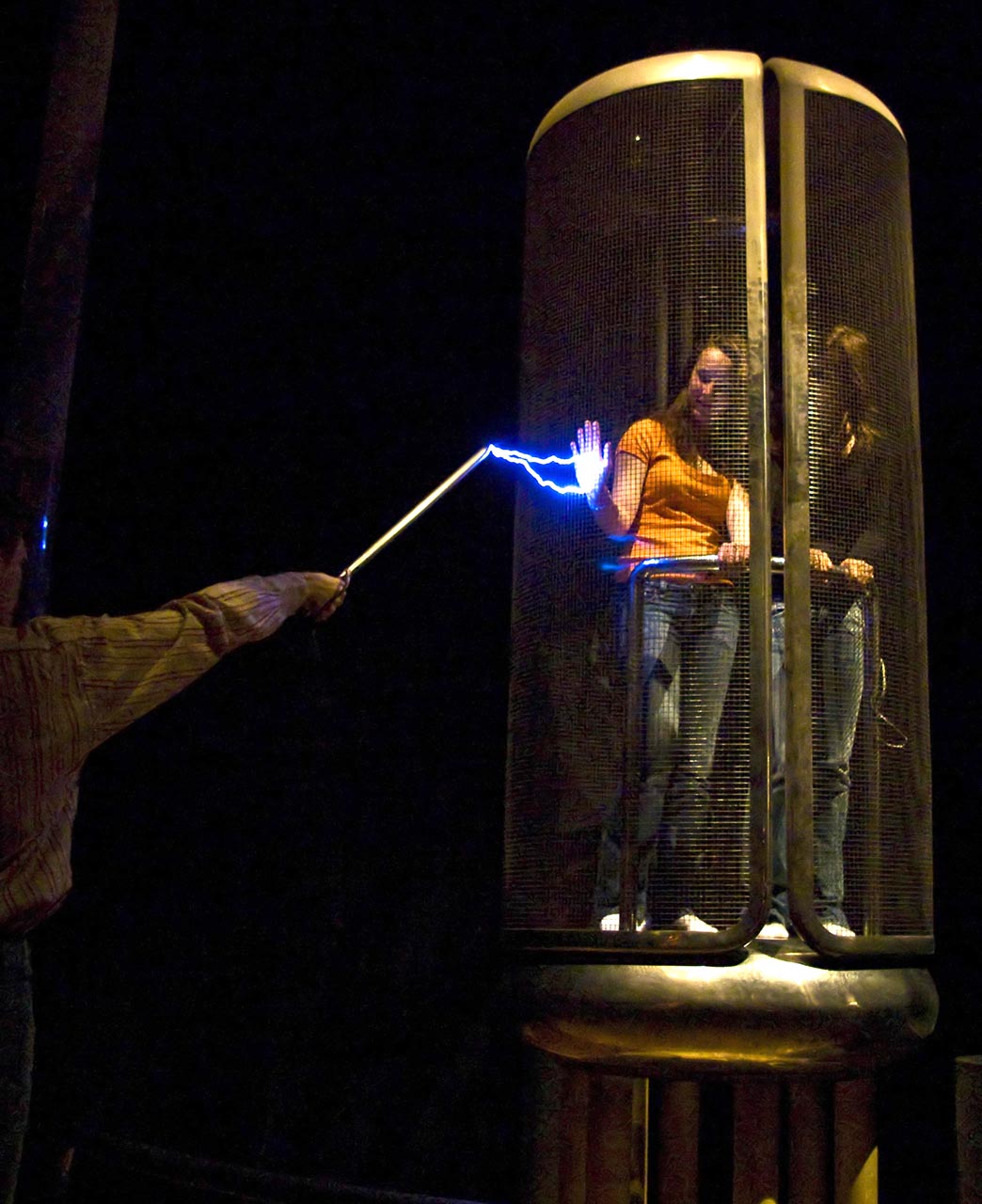|
Electrometer
An electrometer is an electrical instrument for measuring electric charge or electrical potential difference. There are many different types, ranging from historical handmade mechanical instruments to high-precision electronic devices. Modern electrometers based on vacuum tube or solid-state technology can be used to make voltage and charge measurements with very low leakage currents, down to 1 femtoampere. A simpler but related instrument, the electroscope, works on similar principles but only indicates the relative magnitudes of voltages or charges. Historical electrometers Gold-leaf electroscope The gold-leaf electroscope was one of the instruments used to indicate electric charge. It is still used for science demonstrations but has been superseded in most applications by electronic measuring instruments. The instrument consists of two thin leaves of gold foil suspended from an electrode. When the electrode is charged by induction or by contact, the leaves acquire si ... [...More Info...] [...Related Items...] OR: [Wikipedia] [Google] [Baidu] |
Francis Ronalds
Sir Francis Ronalds Fellow of the Royal Society, FRS (21 February 17888 August 1873) was an English scientist and inventor, and arguably the first History of electrical engineering, electrical engineer. He was knighted for creating the first working electric telegraph over a substantial distance. In 1816 he laid an length of iron wire between wooden frames in his mother's garden and sent pulses using electrostatic generators. He also is known for creating the first electric clock in 1814. Upbringing and family Born to Francis Ronalds and Jane (née Field), wholesale cheesemongers, at their business premises at 109 Upper Thames Street, London, Thames Street, London, he attended Unitarianism, Unitarian minister Eliezer Cogan's school before being apprenticed to his father at the age of 14 through the Worshipful Company of Drapers, Drapers' Company. He ran the large business for some years. The family later resided in Canonbury Place and Highbury Terrace, both in Islington, at K ... [...More Info...] [...Related Items...] OR: [Wikipedia] [Google] [Baidu] |
Johann Gottlieb Friedrich Von Bohnenberger
Johann Gottlieb Friedrich von Bohnenberger (5 June 1765 – 19 April 1831) was a German astronomer born at Simmozheim, Württemberg. He studied at the University of Tübingen. In 1798, he was appointed professor of mathematics and astronomy at the University. He published: * ''Anleitung zur geographischen Ortsbestimmung'' (Guide to geographic locations), 1795 * ''Astronomie'' (Astronomy), 1811 * ''Anfangsgründe der höhern Analysis'' (Initial reasons of higher analysis), 1812. In 1817, he systematically explained the design and use of a gyroscope apparatus which he called simply a “Machine.” Several examples of the 'Machine' were constructed by Johann Wilhelm Gottlob Buzengeiger of Tübingen. Johann Friedrich Benzenberg had already mentioned Bohnenberger's invention (describing it at length) in several letters beginning in 1810. Bohnenberger died at Tübingen. The lunar crater Lunar craters are impact craters on Earth's Moon. The Moon's surface has m ... [...More Info...] [...Related Items...] OR: [Wikipedia] [Google] [Baidu] |
Jean Charles Athanase Peltier
Jean Charles Athanase Peltier ( ; ; 22 February 1785 – 27 October 1845) was a French physicist. He was originally a watch dealer, but at the age of 30 began experiments and observations in physics. Peltier was the author of numerous papers in different departments of physics. His name is specially associated with the thermal effects at junctions in a voltaic circuit, the Peltier effect. Peltier introduced the concept of electrostatic induction (1840), based on the modification of the distribution of electric charge in a material under the influence of a second object closest to it and its own electrical charge. Biography Peltier trained as a watchmaker; until his 30s he was a watch dealer. He worked with Abraham Louis Breguet in Paris. Later, he conducted various experiments on electrodynamics and noticed that in an electronic element when current flows through, a temperature gradient or temperature difference is generated at a current flow. In 1836 he published his work a ... [...More Info...] [...Related Items...] OR: [Wikipedia] [Google] [Baidu] |
Kew Observatory
The King's Observatory (called for many years the Kew Observatory) is a Grade I listed building in Richmond, London. Now a private dwelling, it formerly housed an astronomical observatory, astronomical and Terrestrial magnetism, terrestrial magnetic observatory founded by King George III of Great Britain, King George III. The architect was Sir William Chambers; his design of the King's Observatory influenced the architecture of two Irish observatories – Armagh Observatory and Dunsink Observatory near Dublin. Location The observatory and its grounds are located within the grounds of the Royal Mid-Surrey Golf Club, which is part of the Old Deer Park of the former Richmond Palace in Richmond, Surrey, Richmond, historically in Surrey and now in the London Borough of Richmond upon Thames. The former royal manor of Kew lies to the immediate north. The observatory grounds overlie to the south the site of the former Sheen Priory, the Carthusian monastery established by King Hen ... [...More Info...] [...Related Items...] OR: [Wikipedia] [Google] [Baidu] |
Kearny Fallout Meter
The Kearny fallout meter, or KFM, is an expedient radiation meter. It is designed such that someone with a normal mechanical ability would be able to construct it before or during a nuclear attack, using common household items. The Kearny fallout meter was developed by Cresson Kearny from research performed at Oak Ridge National Laboratory and published in the civil defense manual ''Nuclear War Survival Skills'' (). The plans were originally released in Oak Ridge National Laboratory publication ORNL-5040, ''The KFM, A Homemade Yet Accurate and Dependable Fallout Meter'' and have been formatted in a newsprint-ready layout so that they may be quickly printed with accurate dimensions in local newspapers. It must be built from a correctly scaled copy of the plans; photocopies and printouts of digital copies may not be to scale. History Devised in 1978 by Cresson Kearny, the Kearny fallout meter is an application of the gold-leaf electroscope developed in 1787 by Abraham Bennet. Pr ... [...More Info...] [...Related Items...] OR: [Wikipedia] [Google] [Baidu] |
Abraham Bennet
Abraham Bennet FRS (baptised 20 December 1749 – buried 9 May 1799) was an English clergyman and physicist, the inventor of the gold-leaf electroscope and developer of an improved magnetometer. Alessandro Volta cited Bennet as a key influence on his work, although Bennet's own work was curtailed by the political turbulence of his time.Elliott (1999) Life Abraham was baptised in Taxal, Derbyshire, the son of another Abraham Bennet, a schoolmaster, and his wife Ann ''née'' Fallowes. There is no record of him having attended university but he is recorded as a teacher at Wirksworth Grammar School as " MA". He was ordained in London in 1775 and appointed curate at Tideswell and, one year later, additionally at Wirksworth, with a combined annual stipend of £60. He further became rector of Fenny Bentley, domestic chaplain to the Duke of Devonshire, perpetual curate of Woburn and librarian to the Duke of Bedford. Bennet had broad interests in natural philosophy and was a ... [...More Info...] [...Related Items...] OR: [Wikipedia] [Google] [Baidu] |
Lord Kelvin Quadrant Electrometer Engraving
Lord is an appellation for a person or deity who has authority, control, or power over others, acting as a master, chief, or ruler. The appellation can also denote certain persons who hold a title of the peerage in the United Kingdom, or are entitled to courtesy titles. The collective "Lords" can refer to a group or body of peers. Etymology According to the ''Oxford Dictionary of English'', the etymology of the word can be traced back to the Old English word ''hlāford'' which originated from ''hlāfweard'' meaning "loaf-ward" or "bread-keeper", reflecting the Germanic tribal custom of a chieftain providing food for his followers. The appellation "lord" is primarily applied to men, while for women the appellation "lady" is used. This is no longer universal: the Lord of Mann, a title previously held by the Queen of the United Kingdom, and female Lords Mayor are examples of women who are styled as "Lord". Historical usage Feudalism Under the feudal system, "lord" had a wi ... [...More Info...] [...Related Items...] OR: [Wikipedia] [Google] [Baidu] |
Lord Kelvin
William Thomson, 1st Baron Kelvin (26 June 182417 December 1907), was a British mathematician, Mathematical physics, mathematical physicist and engineer. Born in Belfast, he was the Professor of Natural Philosophy (Glasgow), professor of Natural Philosophy at the University of Glasgow for 53 years, where he undertook significant research on the mathematical analysis of electricity, was instrumental in the formulation of the first and second laws of thermodynamics, and contributed significantly to unifying physics, which was then in its infancy of development as an emerging academic discipline. He received the Royal Society's Copley Medal in 1883 and served as its President of the Royal Society, president from 1890 to 1895. In 1892, he became the first scientist to be elevated to the House of Lords. Absolute temperatures are stated in units of kelvin in Lord Kelvin's honour. While the existence of a coldest possible temperature, absolute zero, was known before his work, Kelvin d ... [...More Info...] [...Related Items...] OR: [Wikipedia] [Google] [Baidu] |
William Snow Harris
Sir William Snow Harris (1 April 1791 – 22 January 1867) was a British physician and electrical researcher, nicknamed Thunder-and-Lightning Harris, and noted for his invention of a successful system of lightning conductors for ships. It took many years of campaigning, research and successful testing before the British Royal Navy changed to Harris's conductors from their previous less effective system. One of the successful test vessels was which survived lightning strikes unharmed on her famous voyage with Charles Darwin. Life and work Harris was born in Plymouth on 1 April 1791. His family was well established as solicitors in the town, and he went to Plymouth Grammar School. His childhood in the seaport which included the naval dockyard renamed Devonport gave him an enduring interest in ships. He went to the University of Edinburgh to study medicine and qualified as a physician, then returned to Plymouth and set up a medical practice. His interest in the emerging scien ... [...More Info...] [...Related Items...] OR: [Wikipedia] [Google] [Baidu] |
Zamboni Pile
The Zamboni pile (also referred to as a ''Duluc Dry Pile'') is an early electric battery, invented by Giuseppe Zamboni in 1812. A Zamboni pile is an "electrostatic battery" and is constructed from discs of silver foil, zinc foil, and paper. Alternatively, discs of "silver paper" (paper with a thin layer of zinc on one side) gilded on one side or silver paper smeared with manganese dioxide and honey might be used. Discs of approximately 20 mm diameter are assembled in stacks, which may be several thousand discs thick, and then either compressed in a glass tube with end caps or stacked between three glass rods with wooden end plates and insulated by dipping in molten sulfur or pitch. Zamboni piles of more modern construction were manufactured as recently as the 1980s for providing the accelerating voltage for image intensifier tubes, particularly in military use. Today such voltages are obtained from flyback converters powered by lithium ion batteries. The EMF per elem ... [...More Info...] [...Related Items...] OR: [Wikipedia] [Google] [Baidu] |
Faraday Cage
A Faraday cage or Faraday shield is an enclosure used to block some electromagnetic fields. A Faraday shield may be formed by a continuous covering of conductive material, or in the case of a Faraday cage, by a mesh of such materials. Faraday cages are named after scientist Michael Faraday, who first constructed one in 1836. Faraday cages work because an external electrical field will cause the electric charges within the cage's conducting material to be distributed in a way that cancels out the field's effect inside the cage. This phenomenon can be used to protect sensitive electronic equipment (for example RF receivers) from external radio frequency interference (RFI) often during testing or alignment of the device. Faraday cages are also used to protect people and equipment against electric currents such as lightning strikes and electrostatic discharges, because the cage conducts electrical current around the outside of the enclosed space and none passes through the interior. ... [...More Info...] [...Related Items...] OR: [Wikipedia] [Google] [Baidu] |








